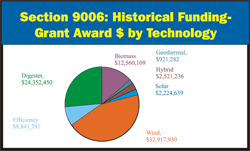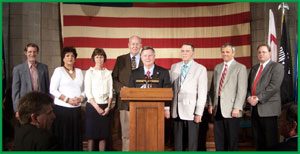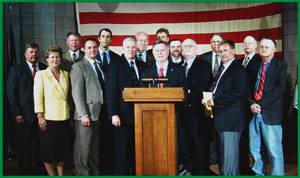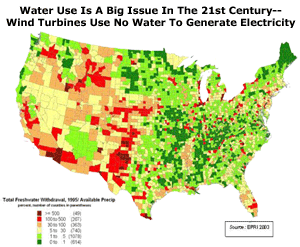| For Immediate
Release |
 Print this
document (ACGF_2007Poster_AWEA_052407
.pdf) Print this
document (ACGF_2007Poster_AWEA_052407
.pdf) |
Contact: Dan McGuire
(402) 489-1346
|
|
Wind Energy Works as an Integral
Part of Future Farm Policy
Author: Dan McGuire
CEO-American Corn Growers Foundation (ACGF)
WASHINGTON, June 4,
2007—“Farm and commodity groups have come together to support
progressive wind energy policies as a result of the ACGF-ACGA
Wealth From The Wind program. The American Agricultural Wind
Coalition (AAWC) continues to inform farm Organization
leadership and continues to promote policies that help both
individual farmers and rural America capture the economic
benefits of wind turbine ownership or wind project involvement,”
says David Senter, AAWC national coordinator and ACCF
consultant, Washington, DC.
“All sectors of agriculture should
embrace the 20% Vision and target getting 20% of our electricity
from wind and other renewable sources by the year 2030. The 20%
Vision is a natural complement to the 25 X 25 Alliance and their
agenda. Wind energy is clean, sustainable, renewable,
efficient, low-cost. We must capture this Wealth From The
Wind for farmers and rural America. Wind energy works for the
benefit of the American economy,” said Dan McGuire, Wind Energy
Works! Coalition steering Committee member.

That’s why the ACGF has carried
out an aggressive, far-reaching outreach and education program
and it’s why the ACGA has taken the lead on federal policies
supporting wind energy.”
- Authorized in 2002
Farm Bill
- 2002 Farm Bill
provided mandatory funding of $23 million per year for 5
years
- Over 1st 4 years of
the program $84.3 million has been awarded which has
leveraged additional investment of approximately $934
million
- Total investment in
rural renewable energy & energy efficiency improvement
projects $1.1 billion
Excerpt below from American Corn Growers Association (ACGA)
testimony at USDA 2007 Farm 11111 Listening Session in
Nashville, TN July 2005
“Since the topic of discussion
is the upcoming farm bill, ACCA suggests retaining and
expanding Title IX of the current farm bill (the energy
title) when drafting the next farm bill, and just as
importantly make sure the energy programs in the current and
new farm bill are fully funded. In teh Case of Section
9006 of Title IX which ahs been funded at near $25 million,
the 2007 farm bill should provide annual
funding/appropriations in the range of $250 million
so that farmers and the rural economy can more quickly
capture the benefits of wind and other renewable energy
systems at a time when renewable energy is so desperately
needed by all U.S. citizens and the U.S. economy," Larry
Mitchell, chief executive officer, American Corn Growers
Association.
Progressive Federal
and State Policies Are Important New Ideas For
Small Wind Energy and Rural Development
Federal: The "Rural Wind Energy Development Act"
(H.R. 1772, also S. 673 in Senate) would provide $1,500 per
one-half kilowatt of capacity for small wind systems. This
bill would provide credits for the installation of wind
energy property, including by rural homeowners, farmers,
ranchers and small businesses, and for other purposes.
State: LB
629-Nebraska Rural Community-Based Energy Development Act
 |
May 21, 2007 Signing
of LB 629 L-R: Senator Don Preister, Senator Vicki McDonald, Senator
Annette Dubas, Senator Cap Dierks (Bill Author),
Governor Dave Heineman, Senator Norm Wallman:
Senator Steve Lathrop; Senator Russ Karpicek. Note:
ALL senators shown were co-sponsors of LB 629. |
May 21, 2007 following signing of LB 629
Front Row (L-R): Shelley Sahling-Zart, Lincoln Electric System;
Robert Byrnes, NE Renewable Energy Association; John
Hansen, President Nebrask Farmers Union; Nebraska
Governor Dave Heineman; Dan McGuire, CEO American
Corn Growers Foundation; Gale Lush, chairman
American Corn Growers Foundation; Rex Woolen, NEFU &
ACGA member. Back Row (L-R): Thomas
Richards, OPPD; Terry Warth, NPPD; Ken Winston,
Nebraska Sierra Club; Senator Cap Dierks, Keith
Dittrich, Chairman American Corn Growers
Association; Martin Kleinschmit, Center for Rural
Affairs; John Dittrich, ACGA; John McClure, NPPD.
|
 |
|
|
"The Nebraska Legislature unanimously passed State Senator Cap
Dierks' Priority Bill, LB 629 on Final Reading May 15th with a
49-0 vote, bringing the C-BED Community Based Energy Development
wind energy model to Nebraska. Nebraska Governor Dave Heineman
signed LB 629 into law on May 21, 2007 with the emergency
clause. The signing ceremony included leaders of the Nebraska
Farmers Union and the American Corn Growers as well as members
of other organizations and Nebraska public power utilities. This
represents an historic and dramatic step forward for both rural
economic development and renewable energy in the public power
state of Nebraska. This is a big win—win for rural Nebraska and
the environment," said John Hansen, President of the Nebraska
Farmers Union.
 We need wind power to
take the pressure off of water demand We need wind power to
take the pressure off of water demand
"According to the National Renewable Energy Laboratory (NREL)
Wind Powering America fact sheet, The Wind/Water Nexus...
'In 2002, fossil fuel and nuclear plants withdrew nearly 225
billion gallons of water per day. Wind energy does not use or
consume water during electricity generation. Greater additions
of wind to offset fossil, hydropower, and nuclear assets in a
generation portfolio will result in a technology that uses no
water, offsetting water—dependent technologies. By diversifying
the generating portfolio energy mix, a utility can manage its
water supply risks.'

...NREL also reports that 'The least efficient water-cooled
plants use as much as 50 gallons of water per kilowatt-hour
(kWh).' My family uses about 3000 kilowatt-hours per month
and in Nebraska, we understand all too well the pressure on
water resources in the west, having experienced seven years of
drought conditions," said Gale Lush, Chairman of the American
Corn Growers Found1ion and a corn farmer from Wilcox, Nebraska.
Our very own Nebraska Public Power District has drilled numerous
deep, high-capacity water wells around the Gerald Gentlemen
coal-fired electrical generation plant because the reservoir
(Lake McConaughy) that they draw cooling water from is only 37%
of normal capacity. Irrigation farmers in the Platte River
valley have already been cut from 8 inches of normal supply to 6
inches annually in order to protect recreation and cooling for
fossil-fueled power plants. We need to do everything we can to
lessen the demand pressure on water. Wind turbines can help a
lot to lessen water use for electricity demand and the
Community-Based Energy Development (C-BED) wind farm ownership
model can provide a new cash crop for farmers and a rural
economic development tool." |
|
(30) |
|
|